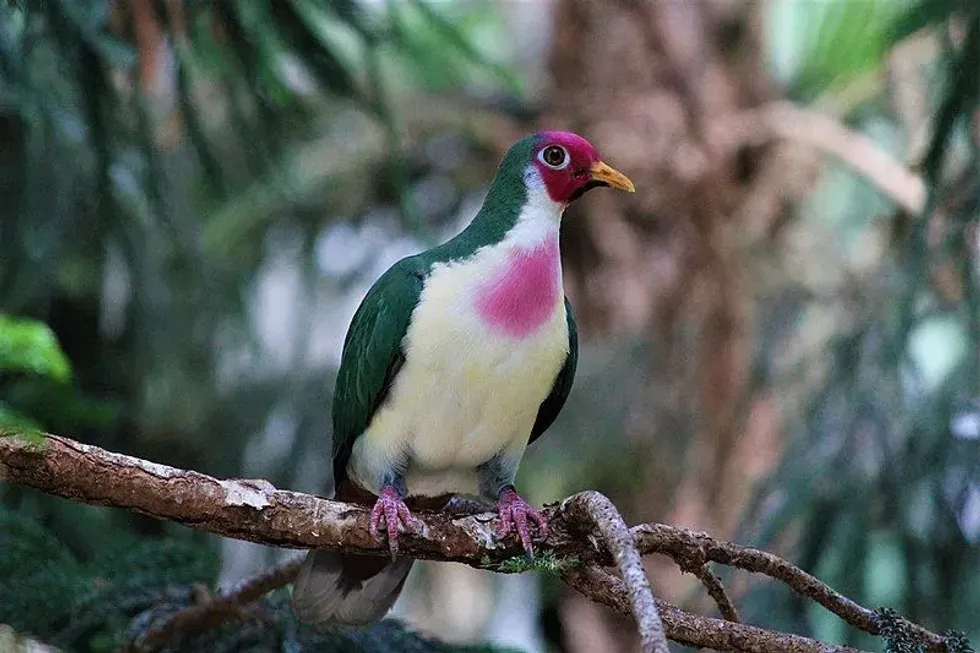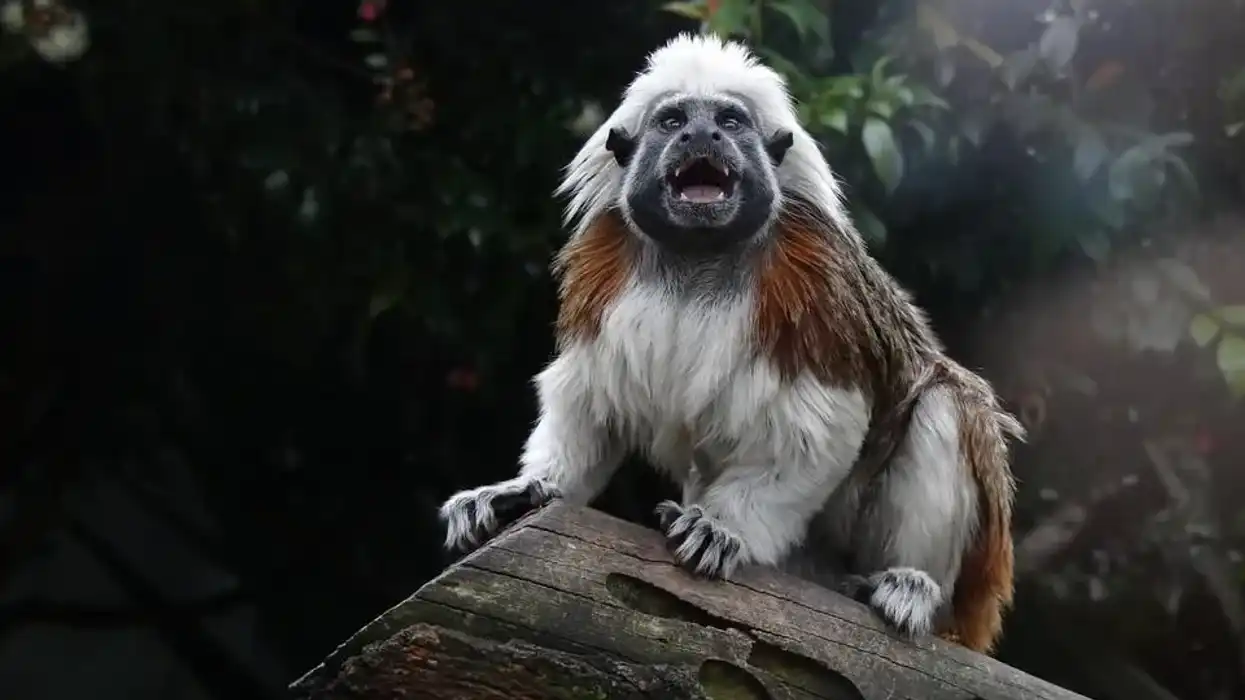The jambu fruit dove (Ptilinopus jambu), is one of the smallest and most unique species of fruit dove. They are mainly native to Indonesia, Malaysia, and Myanmar.
They are bright and colorful and their green feathers make it hard to detect them among the foliage but the soft cooing call of this bird species discloses their existence. They also have a unique orange bill.
The jambu fruit dove inhabits mangrove swamps as well as lowland rainforests up to an elevation of 5000 ft (1,500 m). As their name suggests, they primarily feed on fruit directly from trees or from the ground.
Like other fruit doves, their nostrils are high on their upper bill. They have green upper parts and white underparts. The males have a crimson face and a dark chin. They are very shy and are considered to be one of the most beautiful and elegant species of birds.
If you like what you read, do check out these articles on blue jay facts and common swift facts.
Jambu Fruit Dove Interesting Facts
What type of animal is a jambu fruit dove?
The jambu fruit dove (Ptilinopus jambu) is a species of bird, under the Genus Ptilinopus.
What class of animal does a jambu fruit dove belong to?
The jambu fruit dove (Ptilinopus jambu) found in Malaysia and other countries belongs to the Aves class, like the incredible diamond dove who belongs to the same family and class.
How many jambu fruit doves are there in the world?
The genus Ptilinopus has over 50 species of doves, among which many are extinct while others are endangered or threatened. Unfortunately, the exact population range of these birds is not known.
According to the IUCN Red List, the population trend of this bird species is continuously decreasing, and the birds are facing regular threats from local hunters who hunt and trap terrestrial animals.
They are also suffering from habitat loss due to the practice of wood harvesting.
Where does a jambu fruit dove live?
The jambu fruit dove distribution range covers South East Asia, in the southern parts of Thailand, and extends through Brunei, Kalimantan, Malaysia, Sumatra, and West Java in Indonesia. They reside on rainforest edges, woodlands, mangroves, riversides with a high density of thick forest, in Oceania and Southeast Asia.
What is a jambu fruit dove's habitat?
The jambu fruit dove inhabits mangrove swamps as well as lowland rainforests up to an elevation of 1,500 m. They prefer a dense forest as their ideal habitat because it helps them find food easily.
Who do jambu fruit doves live with?
Jambu fruit doves (Ptilinopus jambu) are not very gregarious, they are rather shy and are usually found either in pairs or in solitary. However, a large flock of this species gathers around feeding sites such as a fruit tree and feeds on fruit directly from the tree or the ones knocked down by hornbills or monkeys.
How long does a jambu fruit dove live?
The average life span of this species is 4-12 years.
How do they reproduce?
Jambu fruit doves (Ptilinopus jambu) are monogamous breeders by nature, which means that both males and females of this species engage with only one partner. The breeding cycle continues from November–February, and July.
The male bird announces their breeding territory, by raising and displaying its wings and cooing while moving the head forward. He then bobs his body up and down. Sometimes when the display fails, generally the males aggressively defend their territory by pecking.
The females build a weak and unstable-looking nest made with sticks, grasses, and roots. They are interwoven into the branches of a tree. The males bring the material needed to build the nest, while the females work on completing the nest.
After mating the female bird generally lays one egg. The incubation period continues for a period of two to three weeks. Both the male and the female help in raising the babies.
The baby chick is found feeding on its mother milk within an hour of hatching. After almost 10 days, the chick finally opens its eyes for the first time. They soon grow strong and mature wings and flies off with their parents.
The chick attains total maturity after eight to 10 weeks. After this span of eight to 10 weeks a baby chick transforms completely into a mature adult bird.
What is their conservation status?
Deforestation and harvesting of woods are continuously threatening the population of the jambu fruit dove. IUCN Redlist declared this species as Near Threatened and like many other species of doves, they might get extinct soon from the jambu fruit dove range map if no conservatory action is taken immediately.
Jambu Fruit Dove Fun Facts
What do jambu fruit doves look like?

The jambu fruit dove (Ptilinopus jambu) is 9 in (22.8 cm) long and has a small head. They have very soft feathers with unique coloring, an orange bill, red legs, and white eye-rings.
The adult male of this species has a crimson face and a blackish chin with green upperparts and white underparts. They also have a pink-colored patch on their breast with a chocolate-brown undertail.
Also, the female jambu fruit dove (Ptilinopus jambu) has a purple dull face and a dark chin. They have green underparts, a white-colored belly, and a cinnamon-colored undertail.
The baby jambu fruit dove adaptations include a great resemblance with the female birds. Though they might look a lot like the females they have green faces and the male babies grow their entire developed plumage after 39 weeks of fledging turning them into an adult.
How cute are they?
The jambu fruit dove (Ptilinopus jambu) is considered very cute due to its diverse and vibrant coloring. A jambu fruit dove photo can melt your heart.
How do they communicate?
The jambu fruit dove is usually very quiet and shy. These birds communicate through vocalization, which includes occasional hoots and very low calls.
How big is a jambu fruit dove?
Compared to a rock dove that is 11-14 in (27.9-35.5 cm) long, the jambu fruit dove appears smaller with a total body length of 9-10.6 in (22.8-26.9 cm) and a wingspan of 13 in (33 cm).
How fast can a jambu fruit dove fly?
Unfortunately, the average flying speed of a jambu fruit dove has not been recorded yet.
How much does a jambu fruit dove weigh?
On average the jambu fruit dove weighs about 1.4 oz (39.6 g).
What are the male and female names of the species?
There are no sex-specific names for the male and the female of this species.
What would you call a baby jambu fruit dove?
A baby jambu fruit dove is usually referred to as a chick, a nestling, or a fledging.
What do they eat?
As the name suggests a jambu fruit dove diet includes fruits directly from fruit trees or fruits dropped on the ground by hornbills or monkeys.
Are they dangerous?
The jambu fruit dove is an incredibly beautiful green feathered bird with a crimson face. They are not very social and prefer to remain solitary, hence, they are not dangerous to anyone.
Would they make a good pet?
The jambu fruit dove is a colorful bird, which for some people might seem ideal to keep as pets. However, their gradual decline in population range (according to the IUCN Redlist) and them being a threatened breed it is unethical as well as illegal to make jambu fruit dove, pets.
Among 50 different variants of fruit dove, only 20-25 of these are allowed to be kept as pets, and the jambu fruit dove isn't one of them.
Did you know...
The conservation status of these birds is near threatened, and if proper conservatory measures are not implied soon, these birds will soon go from being threatened to absolutely extinct.
As these birds are mostly monogamous, when their pairs mate, they stay together for life.
Despite being solitary by nature, they are often found in a large flock as they gather around the feeding site.
Are jambu fruit doves endangered?
The IUCN Redlist has listed the jambu fruit dove as Near Threatened, as their population trend is gradually declining because of habitat loss, harvesting of woods, and hunters.
What is special about the jambu fruit dove?
The jambu fruit dove has vibrant and unique coloring and extremely soft feathers, an orange bill, and a white belly, but their specialty is the power to drink water from water bodies directly with their nostrils submerged in water. They don't need to tilt back their head for the water to drizzle down their throat.
Here at Kidadl, we have carefully created lots of interesting family-friendly animal facts for everyone to discover! For more relatable content, check out these rock facts and dove facts for kids.
You can even occupy yourself at home by coloring in one of our free printable bird coloring pages.
Second image by Greg Hume.









